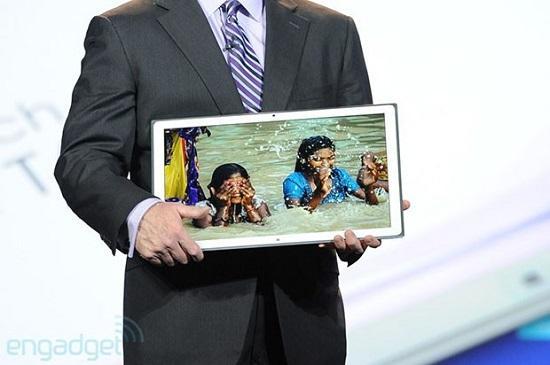

Panasonic is on the ground in Las Vegas, Nevada, showing things off at this year's CES. They aren’t the only ones, of course. A ridiculous number of other companies are in the same area, vying for the attention of a tidal wave of journalists, videographers, tech enthusiasts, and others. But, as I start writing this, Panasonic has a majority share in the attention market at the moment. Why? Because the company just unveiled a tablet that, well, isn't really a tablet at all.
First, can I just say that we have to stop just throwing terms or titles around? Please? This is getting out of hand. Actually, it has been getting out of hand for quite some time, and this particular tablet is just proof of that. Last year, a 13-inch tablet made me scratch my head in confusion, and now that size has even been dwarfed. We’re now looking at a table that is 20-inches!
Really.
That’s what Panasonic unveiled today at CES. As you can see in the image above, courtesy of Engadget, that’s a display that’s as big as that man’s torso. Actually, I think that image is quite fitting for the point that needs to be made about names, devices, and the combination of the two. Look at how he’s holding that “tablet.” It just looks awkward, and it should! It’s 20-inches! No one in their right mind is going to be carrying around a 20-inch tablet. No one’s going to be shoving that in a (huge) bag, and drop it on a coffee shop’s table to get some work done. It’s too big. And, there’s no way it doesn’t have some weight to it.
Like I said, this is getting out of hand. Panasonic could have shown off this particular device as, maybe, an all-in-one PC. It is running a full version of Microsoft’s Windows 8, after all. Because it should be an all-in-one PC. It isn’t a tablet. In fact, it’s a device that actually contradicts the very nature of the tablet market. Portable. Lightweight (hopefully). Even if Panasonic figured out a way to make the 20-inch tablet “lightweight” for a 20-inch tablet, it’s still not going to be light enough to actually be portable.
And, in all honesty, I’d never choose that device over, say, a 10-inch tablet. And even if I can’t keep a tablet, I’d never choose a 20-inch tablet over a 7-inch, or similarly sized tablet. It just wouldn’t happen. Sitting on the couch and holding a 20-inch display on my legs doesn’t sound fun. I don’t care how good the display is.
Ah, the display. Yes, that’s another selling point to this particular “tablet.” It’s got a 4K resolution display. That’s the next stage of high definition for our TVs, and apparently our “mobile” computing devices. Some companies have tagged it as “Ultra HD,” which certainly has a ring to it. This particular 20-inch display has an amazing resolution, and I’m sure images displayed on it would be jaw-dropping to see in person. But it’s still 20-inches. It’s still not a tablet. And I’d much prefer to keep it on my desk.
This is a gimmick, and nothing else. It’s a gimmick to call it a tablet, and everyone at Panasonic has to know full well that no one is going to be carrying it around. The company is now selling an all-in-one PC that doesn’t come with a keyboard and mouse. (It has a touchscreen, though, along with a stylus, so that’s something.)
Back at the end of 2011, Taylor Martin asked you how big a tablet should be, and I’m essentially resurrecting that question. I’m going to say it right now that a 20-inch tablet is too big. It isn’t’ a tablet anymore. It shouldn’t be marketed as such. At 20-inches it’s an inch smaller than the size of my desktop’s display. That’s just . . . Well, that’s ridiculous.
So I’m asking you, Dear Reader. Do you see a purpose to a 20-inch display? Even with one that has 4K resolution? Is that something you’d buy as a tablet? Or, would you plant it on your desk and keep it there? Let me know what you think!
- Log in to post comments
